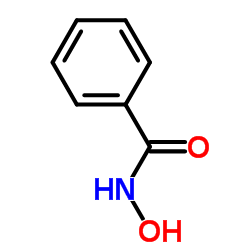Benzohydroxamic acid

Benzohydroxamic acid structure
|
Common Name | Benzohydroxamic acid | ||
|---|---|---|---|---|
| CAS Number | 495-18-1 | Molecular Weight | 137.136 | |
| Density | 1.2±0.1 g/cm3 | Boiling Point | 327.1ºC at 760 mmHg | |
| Molecular Formula | C7H7NO2 | Melting Point | 126-130 °C(lit.) | |
| MSDS | Chinese USA | Flash Point | 201ºC | |
|
Multi-target spectral moment QSAR versus ANN for antiparasitic drugs against different parasite species.
Bioorg. Med. Chem. 18 , 2225-31, (2010) There are many of pathogen parasite species with different susceptibility profile to antiparasitic drugs. Unfortunately, almost QSAR models predict the biological activity of drugs against only one parasite species. Consequently, predicting the probability wi... |
|
|
Intermediate analogue inhibitors of mandelate racemase: N-Hydroxyformanilide and cupferron.
Bioorg. Med. Chem. Lett. 17 , 105-8, (2007) Mandelate racemase (MR) catalyzes the 1,1-proton transfer that interconverts the enantiomers of mandelate. The transition state/intermediate analogues N-hydroxyformanilide (K(i)=2.79+/-0.19 microM) and cupferron (K(i)=2.67+/-0.09 microM) are identified as pot... |
|
|
Dephosphorylation reactions of mono-, di-, and triesters of 2,4-dinitrophenyl phosphate with deferoxamine and benzohydroxamic acid.
J. Org. Chem. 77(23) , 10907-13, (2012) This work presents a detailed kinetic and mechanistic study of biologically interesting dephosphorylation reactions involving the exceptionally reactive nucleophilic group, hydroxamate. We compare results for hydroxamate groups anchored on the simple molecula... |
|
|
Optical spectra of lactoperoxidase as a function of solvent.
Biochemistry 44(48) , 15953-9, (2005) The iron of lactoperoxidase is predominantly high-spin at ambient temperature. Optical spectra of lactoperoxidase indicate that the iron changes from high-spin to low-spin in the temperature range from room temperature to 20 K. The transformation is independe... |
|
|
Nanomolar inhibition of the enterobactin biosynthesis enzyme, EntE: synthesis, substituent effects, and additivity.
Bioorg. Med. Chem. Lett. 16(14) , 3802-5, (2006) 2,3-Dihydroxybenzohydroxamoyl adenylate (I) was prepared as a potential product analog inhibitor of EntE (EC# 2.7.7.58), a 2,3-dihydroxybenzoate AMP ligase from Escherichia coli that is required for the biosynthesis of enterobactin. This compound, obtained by... |
|
|
Inhibition of chymotrypsin by a complex of ortho-vanadate and benzohydroxamic acid: structure of the inert complex and its mechanistic interpretation.
Biochemistry 46(20) , 5982-90, (2007) Serine proteases, like serine beta-lactamases, are rapidly and covalently inhibited by suitably designed phosph(on)ates. The active sites of these enzymes must, therefore, be able to stabilize the pentacoordinated transition states of phosphyl transfer reacti... |
|
|
Reactivation of the alternative oxidase of Yarrowia lipolytica by nucleoside monophosphates.
FEMS Yeast Res. 5(3) , 231-6, (2004) The study of the effect of nucleoside phosphates on the activity of cyanide-resistant oxidase in the mitochondria and submitochondrial particles of Yarrowia lipolytica showed that adenosine monophosphate (5'-AMP, AMP) did not stimulate the respiration of inta... |
|
|
Ring-substituted benzohydroxamic acids: 1H, 13C and 15N NMR spectra and NH-OH proton exchange.
Magn. Reson. Chem. 43(7) , 535-42, (2005) NMR spectra (1H, 13C, 15N) of para- and meta-substituted benzohydroxamic acids were studied in dry dimethyl sulfoxide solutions. The 13C chemical shifts were very close to those found by cross-polarization magic angle spinning in solids, the hydroxamic (not h... |
|
|
On interpretation of a missing spectral band; IR spectra of acidic salts of benzohydroxamic acid.
Spectrochim. Acta. A. Mol. Biomol. Spectrosc. 61(8) , 1899-903, (2005) Using solid benzohydroxamic acid (BHA) as a model compound for its salts, a broad absorption at 2730 cm(-1) was generally agreed to represent the nu(OH) band of the OH... ON bonds. The absence of nu(OH) band in the IR region 3600-1700 cm(-1) was taken to indi... |
|
|
pH-dependent inhibition of mushroom tyrosinase by N-substituted N-nitrosohydroxylamines.
J. Enzyme Inhib. Med. Chem. 23(1) , 16-20, (2008) Several synthetic N-substituted N-nitrosohydroxylamines were found to inhibit mushroom tyrosinase in a pH-dependent manner regardless of the N-substituent. The inhibitory activity, or pI(50) ( - log [IC(50), M]) value, linearly decreased as the pH of the medi... |